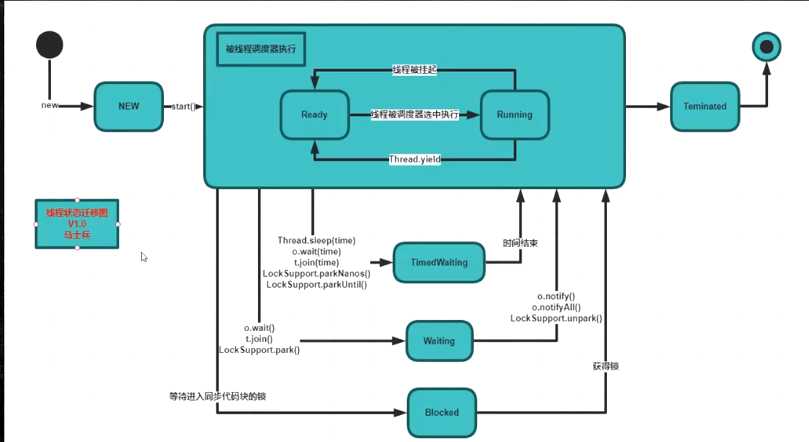线程的状态和常见方法
2021-04-23 14:28
标签:end margin ext sys color rup illegal strong nat 一、线程的状态: 新建状态(NEW):线程刚被创建,还没被启动。 Runable状态:线程对象调用start方法,被线程调度器来执行。 1.就绪状态(Ready):线程被启动,加入CPU等待队列,等待CPU运行。 2.运行状态(Running):在CPU上运行。 结束状态(Terminated):线程正常结束。线程正常结束以后,不能再次调用start方法,会抛出异常:java.lang.IllegalThreadStateException TimedWaiting等待、Waiting等待、Blocked阻塞 测试线程状态: 二、线程常见的几种方法: 1.Sleep:线程睡眠,暂停一段时间让给其他线程去执行,到时间后复活 2.Yield:线程回到等待队列,等待再次被调度 3.Join:当前线程加入调用join方法的线程,本线程等待,等A运行完了以后,B继续执行。 执行结果如下: 线程的状态和常见方法 标签:end margin ext sys color rup illegal strong nat 原文地址:https://www.cnblogs.com/helq/p/13269493.html
public class T04_ThreadState {
static class MyThread extends Thread {
@Override
public void run() {
System.out.println("---state1:" + this.getState());
for (int i = 0; i ) {
try {
Thread.sleep(500);
} catch (InterruptedException e) {
e.printStackTrace();
}
}
}
}
public static void main(String[] args) {
MyThread t1 = new MyThread();
System.out.println("-----state2:"+t1.getState());
t1.start(); //启动线程
try {
t1.join();//main方法等待线程结束
} catch (InterruptedException e) {
e.printStackTrace();
}
System.out.println("-----state3:"+t1.getState());
}
}

/**
* 线程睡眠,暂停一段时间让给其他线程去执行,到时间后复活
*/
static void testSleep(){
new Thread(()->{
for (int i = 0; i ){
System.out.println("-------->T"+i);
if(i % 5 == 0){
try {
TimeUnit.MILLISECONDS.sleep(1000);
} catch (InterruptedException e) {
e.printStackTrace();
}
}
}
}).start();
}
/**
* yield():线程回到等待队列,等待再次被调度
*/
static void testYield(){
new Thread(()->{
for (int i = 1; i ){
System.out.println("-------->A"+i);
if(i % 10 == 0){
Thread.yield();
}
}
}).start();
new Thread(()->{
for (int i = 0; i ){
System.out.println("-------->B"+i);
if(i % 10 == 0){
Thread.yield();
}
}
}).start();
}
/**
* join(): 当前线程加入调用join方法的线程,本线程等待,等A运行完了以后,B继续执行。
*/
static void testJoin(){
Thread t1 = new Thread(()->{
for (int i = 0; i ) {
System.out.println("------>A0"+i);
}
});
t1.start();
new Thread(()->{
for (int i = 0; i ){
if(i == 4){
try {
t1.join();
} catch (InterruptedException e) {
e.printStackTrace();
}
}
System.out.println("B0"+i);
}
}).start();
}

上一篇:利用python输出九九乘法表
下一篇:07Python模块化编程